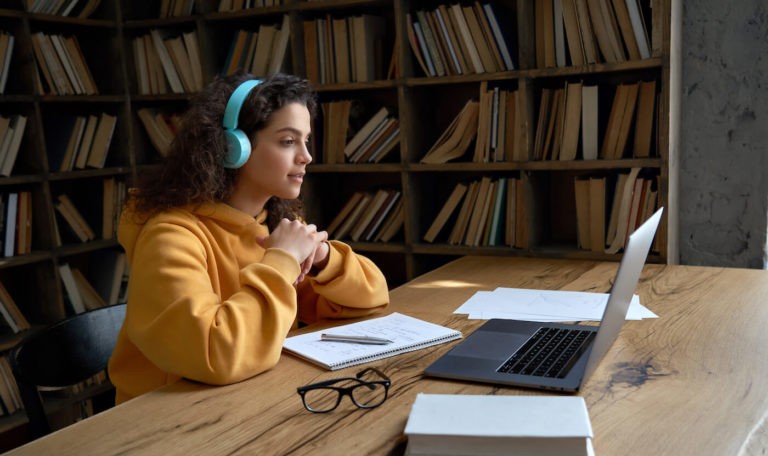Why Might Some Students Be Hesitant to be on Camera?
Even if students have the resources at home to maintain the sanctity of school hours and to access video streaming consistently (which we must acknowledge is not true for many students), there are other issues with being asked to turn their cameras on while away from school.
Privacy
Students may be embarrassed about their living conditions due to socio-economic disparities, the other people present in the home, or because of something as basic as cleanliness. Some log in from a bathroom or a closet just to have a quiet place to learn. Homeless students logging in from a shelter, a car, or a local business establishment may not wish to answer the queries of curious classmates. Others, such as victims of violence or undocumented immigrants, require privacy in order to feel safe. There are also legitimate concerns about the security of some video streaming services.
Student Mental and Emotional Health
Most adolescents already believe everyone is looking at them. Add to that the presence of 20 faces in boxes staring back at them for an entire class period, and the negative self-talk that students often play on repeat in their minds is only amplified. That feeling that everyone is staring at them can cause a ‘flight or fight’ response in students that elevates feelings of anxiety and stress. The distraction and anxiety that can be felt as a result of the magnified mirror effect of watching one’s own face while watching the faces of others watch one’s face can affect the ability of students to concentrate and meaningfully participate in class.
The human brain has become incredibly adept at decoding and synthesizing verbal and nonverbal communication cues in order to create a complete communication picture. In a video call, the brain is impeded in its ability to collect this information because it can only see part of the person talking. It’s trying to figure out how to read the body language of the floating head in front of it…it simply does not compute. As the brain struggles to fill in the blanks, we become exhausted and “Zoom fatigue” sets in. After a full school day of video calls, many students (and adults) find themselves mentally and physically exhausted.
How to Engage Students with the Camera Off
Build Relationships
In any classroom, relationships are key. The more supportive and positive, the more likely students will be to participate. In a virtual classroom, use virtual icebreakers to get to know one another and find common ground. Students can respond in the chat or via a video link. Getting students excited to show their classmates something about themselves can be the first step to getting the cameras on. Games encourage student engagement. Try virtual variations on easy classics like Pictionary, charades, or rock, paper, scissors.
Capitalize on the momentum of positive connection by establishing a class social. By having honest dialogue about what is expected and holding each other accountable, all members of the class foster a safe learning environment (even a virtual one). Further leverage these relationships by asking students to identify others they’d like to work with in small groups. This serves two purposes: student choice can increase the likelihood they will use their cameras to participate, and it can allow teachers to identify the students who hold the most social capital, the ones whose participation is most likely to encourage others to turn on their cameras.
If some still resist turning on the camera, teachers should remain empathetic and work to understand the barriers their students face. By admitting students individually to class via a virtual waiting room, teachers have a moment to reinforce the positive relationship and to ask if they’d feel comfortable keeping their camera on. If not, they can thank them for simply turning it on to say hi, and try again next time.
Video-Optional Assignments
Encourage participation by providing video-optional assignments. One way to incorporate student choice is to assign small group projects where students can decide how they want to collaborate – a shared document, video chat, messaging, etc. Instead of asking all students to have their cameras on constantly during a class meeting, teachers might try organizing Socratic seminars in which the “inner circle” has their cameras on while the rest of the class comment and critique via the chat function with their cameras off.
Use a Variety of Tools
The most frequently used justification for keeping cameras on is that teachers cannot “tell” if students are engaged with cameras off. The tricky thing is that even with cameras on, students can be disengaged, just as they can be when sitting in a physical classroom. Use a variety of tools to ensure that all students are participating in learning.
While conducting formative assessments, use online polling tools such as Poll Everywhere, Mentimeter, or Micropoll or learning games like Kahoot, GimKit, or Quislet Live. Quick, spontaneous responses may also be given via the chat and polling features embedded in the video streaming program. Several add-on features such as PearDeck or Nearpod can be used to create interactive slideshows. The chief benefit to these is that built-in participation cues can be pre-planned and the teacher and class have an artifact of student participation to review after the class is over.
Pre-Record Video Participation
Another way to allow student choice in how, not if, they participate is to allow for pre-recorded videos in response to questions and to demonstrate skills. Flipgrid is one virtual venue in which students record short video responses that can be shared with a class while being monitored by the teacher.




